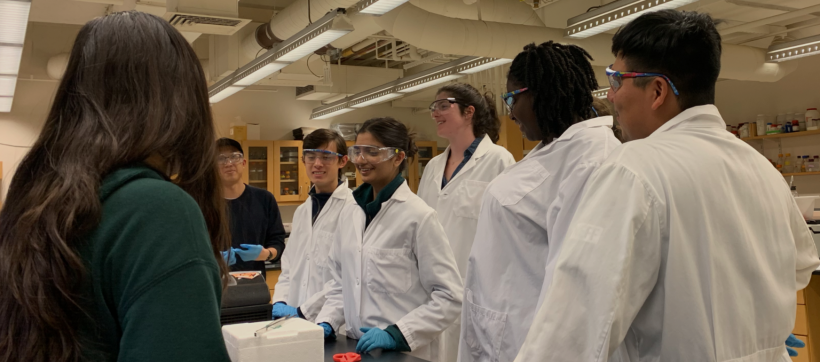20.109(S20):Characterize clone by titration using flow cytometry (Day4)
Contents
Introduction
Protocols
Today, you will be analyzing the scFv clone that you selected via sequence alignment during our last laboratory session for binding to lysozyme. Your goal for today is to complete Part 1 of the protocol with one hour to spare at the end of this session. At this point, we will all walk over to the flow cytometer to begin analyzing our scFvs.
Part 1: Prepare Titration Lysozyme with scFv Clone on Yeast
Prior to this session, the instructors transformed your chosen sequence back into yeast and grew up transformed colonies on SDCAA selective plates. Next, they picked an individual colony to grow up in SDCAA media culture. After a day of growth, the culture was passaged (i.e. spun down and resuspended) into SGCAA media to induce expression of your scFv on the surface of the yeast.
Retrieve yeast culture labelled with your groups color from 20°C incubator
- Measure the optical density (OD) of your yeast on the spectrophotometer.
- Blank the spectrophotometer with >1000 uL of SGCAA media in a clear cuvette
- Add 900 uL of SGCAA media to a new cuvette. Add 100 uL of your yeast culture and mix well by pipetting up and down.
- Record the OD(@600nm) of your sample by taking a measurement using the spectrophotometer and multiplying by 10 (to account for the 10x dilution).
- Determine how many microliters of your sample are required to analyze 1x106 yeast cells.
- The conversion rate from OD to cells for yeast is: (107 yeast cells)/(OD x mL of culture)
- Thus, An optical density of 1 at 600nm equals 107 yeast cells per mL.
- Add 10 microcentrifuge tubes to your rack and label them 1-10 with tape matching your team’s color.
- Add the correct volume of culture (calculated above) such that 10^6 yeast are added to each tube.
- Add an additional 900 uL of PBSA to each centrifuge tube and pellet the cells for 2 minutes in microcentrifuge at 4000xg.
- Discard supernatant carefully with vacuum aspirator or with pipette (Do not touch or disturb the yeast pellet!). Wash with an additional 1 mL of PBSA, pellet, and remove supernatant. Repeat washing step once more.
Retrieve biotinylated lysozyme stock solution from instructors
- Use additional microcentrifuge tubes to prepare dilutions of lysozyme stock solution in PBSA
- Start by making a 2000 uL volume sample of 1000 nM biotinylated lysozyme. Then, calculate and prepare dilutions from that sample in additional microcentrifuge tubes (starting with 1500 uL of 316 nM solution, then 1500 uL of 100 nM solution, etc.)
- Add 1000 uL of correct concentration of lyzosyme solution to each labeled sample tube as directed below (Tubes 1-8). Carefully, resuspend the pelleted yeast. Add 1000 uL of PBSA (no lysozyme) to Tubes 9 and 10.
- Tube 1 = 1000 nM biotinylated lysozyme + 106 displaying yeast cells
- Tube 2 = 316 nM biotinylated lysozyme + 106 displaying yeast cells
- Tube 3 = 100 nM biotinylated lysozyme + 106 displaying yeast cells
- Tube 4 = 31.6 nM biotinylated lysozyme + 106 displaying yeast cells
- Tube 5 = 10 nM biotinylated lysozyme + 106 displaying yeast cells
- Tube 6 = 3.16 nM biotinylated lysozyme + 106 displaying yeast cells
- Tube 7 = 1 nM biotinylated lysozyme + 106 displaying yeast cells
- Tube 8 = 0.1 nM biotinylated lysozyme + 106 displaying yeast cells
- Tube 9 = 106 displaying yeast cells (secondary staining only) (no lysozyme)
- Tube 10 = 106 displaying yeast cells (no staining) (no lysozyme)
- Add primary staining to samples: Add 1 uL of the chicken antibody specific for the c-myc tag (GaCmyc mAb) to Tubes 1-8
- Incubate samples on nutator at 4°C for 30-60 minutes.
- After incubation, pellet cells at 4000xg for 2 minutes. Discard supernatant carefully with vacuum aspirator or with pipette (Do not touch or disturb the yeast pellet!). Wash with an additional 1 mL of PBSA, pellet, remove supernatant, and resuspend with 1 mL of PBSA.
- Add secondary staining to samples: Add 1 uL of goat polyclonal antibody mix labelled with Alexa Fluor 488 specific for chicken antibodies (GaC488) and 1 uL of streptavidin labelled with Alexa Fluor 647 (SAV647) to Tubes 1-9.
- Incubate samples on nutator at room temperature for 20-30 minutes.
- After incubation, pellet cells at 4000xg for 2 minutes. Discard supernatant carefully with vacuum aspirator or with pipette (Do not touch or disturb the yeast pellet!). Wash with an additional 1 mL of PBSA, pellet, remove supernatant, and resuspend with 1 mL of PBSA.
- Place samples on ice and give them to the instructors.
Part 2: Accuri Flow Cytometry of Stained Yeast Samples
At this point, we will watch as one of the instructors prepares the flow cytometer to analyze our stained samples.
Reagents list
SDCAA (Minimal yeast media composed of salts, Difco yeast nitrogen base, dextrose, and casmino acids) SGCAA (Minimal yeast media composed of salts, Difco yeast nitrogen base, galactose, and casmino acids) PBSA (Phosphate-buffered-saline solution with 0.1% w/v Albumin) Biotinylated lysozyme stock solution (prepared by instructors, Sigma Aldrich) Primary Staining Reagents:
- Chicken anti-cMyc Ab (1:1000, Gallus)
Secondary Staining Reagents:
- Streptavidin AlexaFluor 488 conjugate (1:1000, Life Technologies)
- Goat anti-chicken AlexaFluor647 Ab (1:1000, Life Technologies).
Next day: Analyze titration curves
